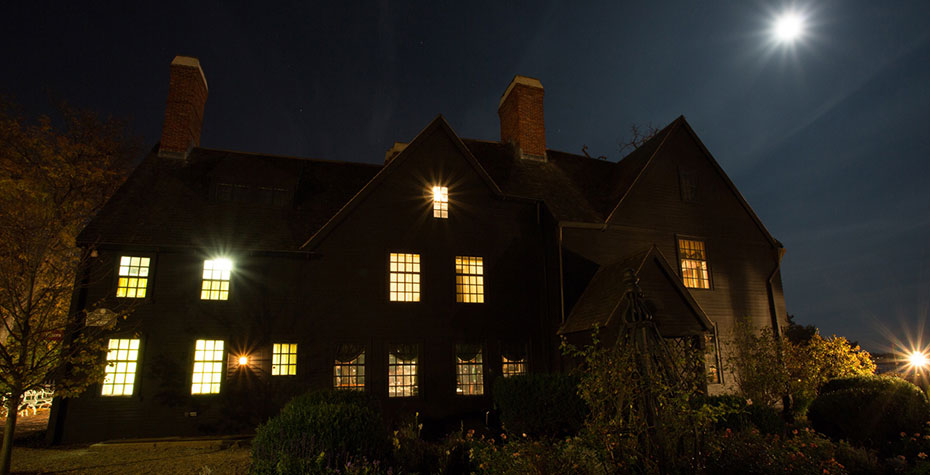Kara McLaughlin ’89 Talks about How She Came to Direct Salem’s House of the Seven Gables

Wellesley has a long-standing tradition of producing curators and museum directors of all kinds; for instance, Alvia Wardlaw ’69 curated 1989’s ground-breaking Black Art Ancestral Legacy: The African Impulse in African-American Art, while Eleanor Garvey ’40 spent 16 years curating Harvard’s Houghton Library. Both art history majors, Wardlaw and Garvey likely had some idea that they would head into the curatorial field following their graduation; however, not all paths are so clear. Take Kara McLaughlin ’89: a Wellesley political science major with a concentration in German, who this year became the curator/executive director of the House of Seven Gables in Salem, Mass.
The 1668 wooden mansion is listed among "best haunted house tours" or "spookiest Halloween places" by the likes of This Old House, Trip Advisor, Fodor's, and others. October 31 is indeed a big day at "The Gables" but it has a year-round mission of education, outreach, and service.
This historic home and former settlement house was the inspiration for Nathaniel Hawthorne’s novel of the same name. McLaughlin, however, says, “I was not a history major, I was not a literature major, I never really went to museums or anything like that. I was a political science major with a concentration in German and did part-time work with a consulting firm [the Survey Group] during my time at Wellesley.”
After working for several years in human resources in Germany, McLaughlin returned to her home state of Massachusetts to pursue an MBA at Northeastern University, and went on to serve as the president of the Survey Group, where she had worked while an undergrad. Following the birth of her children, McLaughlin chose to step down from her role as president, and returned to school to pursue a master's in education from Lesley University; she taught for approximately three and-a-half years.
Then, in 2013, she got a call from a former colleague about an opening at the House of Seven Gables, and by February 2013 she had been accepted as its interim executive director and named the permanent executive director in January 2014. She has been fascinated and inspired by getting to know more about the House of Seven Gables and the history of founder Caroline Emmerton’s settlement mission.
“Caroline Emmerton was truly one of the first social entrepreneurs,” says McLaughlin. “She recognized that she could make money giving nickel tours of her house, and then spend that money to promote the mission of settlement.” Settlement houses, popular in the late 19th and early 20th centuries, were institutions designed to help assimilate immigrants, and provided services such as education, housing, and food.
Today, the House of Seven Gables is indeed a famous tourist attraction but continues its settlement legacy with community outreach and education, now serving a largely Hispanic immigrant population, in contrast to the European immigrants of the past. In response to this demographic shift, the House offers very different services than it has in the past. Two years ago, the House of Seven Gables collaborated with the National Park Service to put together “America’s Best Ideas,” a project inspired by historian Ken Burns. The program connected inner city youth in Salem with their nation of origin by teaching the history of both places’ relationship using a dual language model. McLaughlin has been working with local organizations to coordinate broader settlement efforts outside of the House’s seven gables.
As noted, in addition to its civic role in the Salem community, the House of Seven Gables takes Halloween very seriously. Although you won’t find jack-o-lanterns or skeletons on site, plenty of ghosts make their presence known in and around the House of Seven Gables and the associated birthplace of American writer Nathaniel Hawthorne during the month of October. Visitors will be haunted by “ghosts” of years gone by during historically-accurate tours of Hawthorne’s birthplace that share stories of those persecuted during witch hunts led by a relative of Hawthorne’s. Those more interested in Hawthorne’s The House of Seven Gables can also meet with characters from the story during tours of the real-life House of Seven Gables, which depart every five to 10 minutes.
Says McLaughlin, “We do about 30 percent of our business in October... so if 90,000 people come throughout the course of the year, 30,000 come in October.”
Despite all of the fun that is Salem at Halloween, McLaughlin is still most enthusiastic about her ability to study women like Caroline Emmerton (1866-1942), the founder of the House of Seven Gables as an institution, as well as Susan Ingersoll (1783-1858), a cousin of Hawthorne and a past owner of the House.
“Caroline Emmerton was selected as the Person of the Century [in 1999] in Salem for her work, and she was truly a woman ahead of her time,” says McLaughlin. “Susanna Ingersoll inherited her wealth and was pretty young when she did. Though she had several propositions for marriage she didn’t take any of them up. She then proceeded to become a successful businesswoman on her own.”
With these strong women as inspiration, and Wellesley as a foundation for her own varied educational and experiential path, McLaughlin makes the House of Seven Gables a platform for making a difference in the lives of others, as she leads programs such as English language instruction; first jobs training for teens; enrichment experiences; educational support; and more, to help each young person reach his or her full potential.
—Katelyn Campbell ’17
